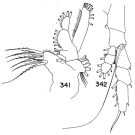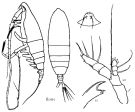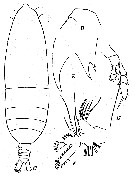|
|
 |
Fiche d'espèce de Copépode |
|
|
Calanoida ( Ordre ) |
|
|
|
Arietelloidea ( Superfamille ) |
|
|
|
Augaptilidae ( Famille ) |
|
|
|
Haloptilus ( Genre ) |
|
|
| |
Haloptilus longicirrus Brodsky, 1950 (F) | |
| | | | | | | Syn.: | Haloptilus setuliger Tanaka, 1964 b (p.40, Descr.F, figs.F); Itoh, 1970 a (p.5: tab.1); Matthews, 1972 (p.50-51, Rem., 54); Harding, 1974 (p.141, tab.2); Park, 1988 (p.21, Rem.); Shih & Young,1995 (p.68); Lo & al., 2004 (p.89, tab.1);
no Haloptilus longicirrus : Bradford, 1970 a (p.359, figs.F) | | | | Ref.: | | | Brodsky, 1950 (1967) (p.363, Descr.F, figs.F); Grice, 1963 a (p.498, figs.F); Vervoort, 1965 (p.124, Rem.); Park, 1970 (p.535, figs.F, Rem.); Minoda, 1971 (p.40); Matthews, 1972 (p.50); Park, 1988 (p.21, Descr.F, figs.F, Rem.); Razouls, 1994 (p.195, figs.F); Bradford-Grieve & al., 1999 (p.883, 941, figs.F); Vives & Shmeleva, 2007 (p.256, figs.F, Rem.) |  Comparison between H. longicirrus and H. paralongicirrus issued from : T. Park, 1970, 1988. Haloptilus longicirrus Female: 1, habitus (dorsal view); 2 & 2', Head (dorsal, ventral, respectively); 3, 3', 3'', Urosome (dorsal, ventral, lateral, respectively) . Haloptilus paralongicirrus Female: 4, dorsal view; 5 & 5', Head (dorsal, ventral, respectively); 6 & 6', Urosome (dorsal, ventral, respectively); 7 & 7', genital segment (lateral, ventral, respectively).
|
 issued from : T. Park in Antarct. Res. Ser. Washington, 1988, 47. [p.22, Fig.13]. Female : a, forehead (dorsal); b, urosome (ventral). Nota: Riostral filaments well developed.
|
 Issued from : T. S. Park in Bull. Mar. Sc., 1970, 20 (2). [p.534, Figs.330-340]. Female (from Caribbean Sea & G. of Mexico): 330, habitus (dorsal); 331, idem (lateral right side); 332, forehead (dorsal); 333, idem (ventral); 334, idem (lateral); 335, urosome (dorsal); 336, idem (lateral right side); 337, genital segment (ventral): 338, A2; 339, Md; 340, Md (biting edge). Nota: Forehead with a round projection, which in dorsal view is not set off as it is in H. longicornis. Genital segment about as wide as long, and two spermathecae widely separated. Caudal rami more than twice as long as wide.
|
 Issued from : T. S. Park in Bull. Mar. Sc., 1970, 20 (2). [p.536, Figs.341-342]. Female: 341, Mx1; 342, P5 (anterior). Nota: Exopod of A2 7-segmented. Basis of Mx1 with 5 setae. P5: coxa and 2nd exopodal segment each with a small internal seta; basis with an external seta which is about twice as long as exopod.
|
 Issued from : K.A. Brodskii in Calanoida of the Far Eastern Seas and Polar Basin of the USSR. Opred. Fauna SSSR, 1950, 35 (Israel Program for Scientific Translations, Jerusalem, 1967) [p.363, Fig.254]. Female (from NW Pacific): habitus (dorsal and lateral left side); forehead (ventral); M, Md (biting edge); S5, P5 (probably the inner seta on basipodal segment 1 is lacking in the figure).
|
 issued from : G.D. Grice Bull. mar. Sc. Gulf Caribb., 1963, 13 (4). [p.499, Fig.C-G].
Female (from NW toppical Atlantic): C, habitus (dorsal); D, forehead (lateral); E, Md (biting edge); F, Mx1; G, P5.
|
 Issued from : C. Razouls in Ann. Inst. océanogr., Paris, 1994, 70 (1). [p.195]. Caractéristiques morphologiques de Haloptilus longicirrus femelles adultes. Terminologie et abbréviations: voir à Calanus propinquus.
| | | | | Ref. compl.: | | | Park, 1970 (p.478); Roe, 1972 (p.277, tabl.1, tabl.2); 1972 c (p.1034); Deevey & Brooks, 1977 (p.156, tab.2, Station "S"); Buchanan & Sekerak, 1982 (p.41, vertical distribution); Vives, 1982 (p.293); Lozano Soldevilla & al., 1988 (p.60); Errhif & al., 1997 (p.422); Razouls & al., 2000 (p.343, Appendix); Yamaguchi & al., 2002 (p.1007, tab.1); Galbraith, 2009 (pers. comm.); Park & Ferrari, 2009 (p.143, Table 4, Appendix 1, biogeography); Homma & Yamaguchi, 2010 (p.965, Table 2); Medellin-Mora & Navas S., 2010 (p.265, Tab. 2); Hsiao S.H. & al., 2011 (p.475, Appendix I); Homma & al., 2011 (p.29, Table 2, abundance); Bonecker & a., 2014 (p.445, Table II: frequency, horizontal & vertical distributions, Table IV: new geographical record) | | | | NZ: | 10 + 1 douteuse | | |
|
Carte de distribution de Haloptilus longicirrus par zones géographiques
|
| | | | | | | | | | | |  Carte de 1996 Carte de 1996 | |
| | | | Loc: | | | Antarct. (SE Pacif.), Indian (S subtropical convergence), SW Atlant., Brazil (off Rio de Janeiro), G. of Guinea, Canary Is., Caribbean Colombia, Caribbean Sea, Caribbean Colombia, G. of Mexico, off Bermuda (Station "S"), Sargasso Sea, off SE Cape Cod, NW Pacif., Station Knot, Bering Sea, S Aleutian Basin, S China Sea, Vancouver Is., Taiwan (Kuroshio Current); ? Arctic (W Baffin Bay in Buchanan & Sekerak, 1982 (p.41, Table 2) | | | | N: | 22 | | | | Lg.: | | | (16) F: 3,1-2,84; (22) F: 3,4; (69) F: 3,27; (87) F: 3,2-2,9; (88) F: 3,32-2,96; (199) F: 3,04-2,89; (208) F: 3,77; (313) F: 2; {F: 2,00-3,77} | | | | Rem.: | bathy-abyssopélagique.
Sampling depth (Antarct.): 0-600 m.
Vervoort signale la ressemblance avec H. longicornis.
Voir aussi les remarques en anglais | | | Dernière mise à jour : 29/01/2017 | |
|
|
 Toute utilisation de ce site pour une publication sera mentionnée avec la référence suivante : Toute utilisation de ce site pour une publication sera mentionnée avec la référence suivante :
Razouls C., Desreumaux N., Kouwenberg J. et de Bovée F., 2005-2025. - Biodiversité des Copépodes planctoniques marins (morphologie, répartition géographique et données biologiques). Sorbonne Université, CNRS. Disponible sur http://copepodes.obs-banyuls.fr [Accédé le 30 novembre 2025] © copyright 2005-2025 Sorbonne Université, CNRS
|
|
 |
 |









